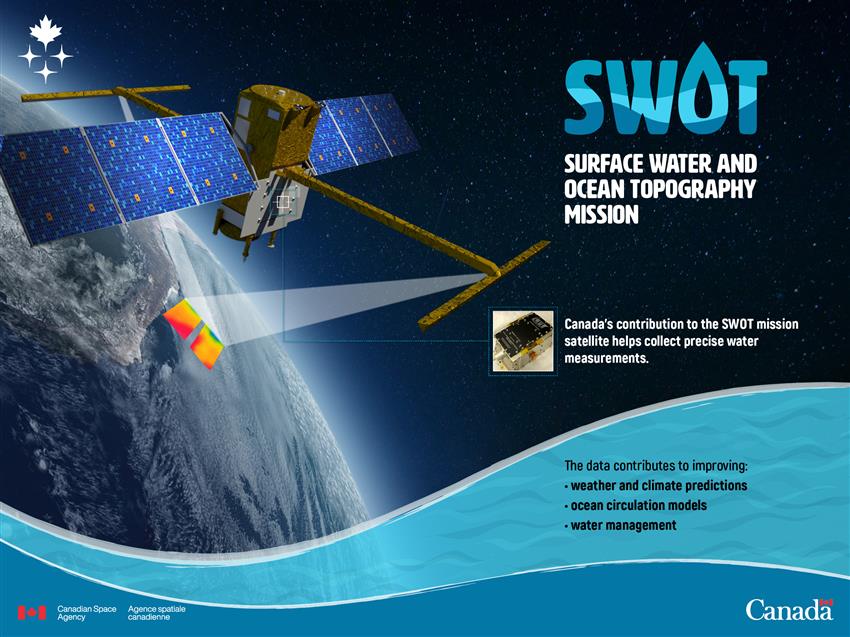The Surface Water and Ocean Topography (SWOT) mission
- Launch:
- Mission duration: 3 years with possibility to extend
- Mission status: Active
An international mission
The SWOT mission is providing us with new and detailed information on one of the most important resources we share – water.
Led by NASA and France's space agency (CNES), SWOT surveys 90% of Earth's surface water; observes the fine details of the ocean's surface topography; and measures how lakes, rivers, reservoirs and oceans are changing over time.
By using innovative technology, SWOT measures ocean features at spatial scales up to 10 times smaller than previous technologies can. These precise measurements provide the scientific community with a better understanding of the dynamics of the world's oceans and terrestrial surface water, allowing them to address important global issues like climate change and improve our management of water as a strategic resource.
2017-01-16 – This animation shows the SWOT mission satellite collecting precise water measurements. (Credits: NASA, JPL-Caltech)
Canada's contribution
Canada's participation in this mission brings significant benefits: it builds on the strength and expertise of our industry and its economic growth; it also represents an important gain in scientific knowledge.
Technology
The Canadian Space Agency (CSA) accepted NASA's invitation to participate in the SWOT mission by providing a key component of the wide-swath radar instrument – a set of extended interaction klystrons (EIKs). This is a modest contribution to this major US$1.2B investment but nevertheless crucial, as the EIKs amplify the power needed by the wide-swath instrument to generate the microwave pulses that are used to measure water surface elevation.
Communications & Power Industries Canada Inc. is world-renowned for its expertise in building this sophisticated device, as no other firms have a proven record of building and flying space-grade EIKs.

Text version of the infographic SWOT - Surface Water and Topography Mission
SWOT - Surface Water and Topography Mission infographic. (Credit: CSA)
Science
Through this partnership, Canadian scientists obtained privileged access to software tools required to understand SWOT data. SWOT data is expected to lead to improvements in many water-related services in Canada, including flood warning systems, sea level and ocean currents monitoring, and implementing sustainable water management policies.
The SWOT Canadian science team, led by Environment and Climate Change Canada (ECCC) and Fisheries and Oceans Canada, is working towards mission objectives and desired outcomes within two main areas of research, hydrology and oceanography, to enhance our understanding of:
- the water cycles across the country;
- sea level changes and ocean current variations in Canadian waters.
Hydrology

| Mission objectives | Desired outcomes |
|---|---|
|
|
Oceanography

| Mission objectives | Desired outcomes |
|---|---|
|
|
Benefits to Canadians
The information received will greatly improve the delivery of services related to key national priorities related to water, such as marine safety and security, water management, responsible resource development, environmental monitoring, fisheries, climate change adaptation, marine transportation and sustainable development in the North. For example:
Marine safety and security

Example: Support the Canadian Coast Guard's search and rescue operations at sea by providing better information on currents to more accurately forecast the positions of drifting objects, ice and icebergs.
Water management

Example: Environment and Climate Change Canada, in cooperation with provincial and territorial partners, monitors water level and flow at approximately 2500 key locations on lakes and rivers in Canada (Water Survey of Canada). Due to the complexity and cost of operating ground-based hydrometric monitoring gauges, especially in remote regions, this represents only a small fraction of the total number of lakes and rivers in Canada. SWOT provides coverage of most lakes and rivers up to four times every three weeks, including northern Canada, where very few measurements were taken previously. This global inventory of Canadian waters serves to improve our water management and assist in prediction of floods and drought.
Responsible resource development

Example: Measurements provided by SWOT benefit user communities such as structural engineers who use hydrometric data to optimize the design of various types of structures such as bridges, culverts, pipeline crossings, dams, reservoirs, hydroelectric plants, dykes and other water-related structures.
Environmental monitoring

Example: Support the management of ecological disasters such as oil spills and/or other potential contaminants by providing precise forecasts of the dissemination of contaminants.
Canadian fisheries

Example: Support Canadian fisheries' activities by monitoring the patterns of commercial species migrations to provide fish harvesters with accurate predictability of fish locations using highly precise information on ocean eddies in zones of high productivity.
Marine transportation

Example: Provide optimized shipping routes based on accurate knowledge of marine currents. These optimized shipping routes have demonstrated up to 8% savings on time and fuel for crossing the Atlantic, which represents a significant efficiency improvement for marine operators.
Sustainable development in the North

Example: SWOT's high-valued data will assist decision makers in the development of new infrastructure in the North. One of the by-products of SWOT, that adds to data provided by other satellites, is the measurement of sea-ice thickness, which facilitates maritime traffic in icy waters. Information provided to the government on water quality and quantity will support biodiversity and habitat assessments, as well as environmental prediction activities.
Participating universities
- Université de Sherbrooke
- University of Toronto
- McGill University
- Dalhousie University
- Wilfrid Laurier University
- Université Laval
- Guelph University
- Concordia University
- Université du Québec à Rimouski
- University of Victoria

